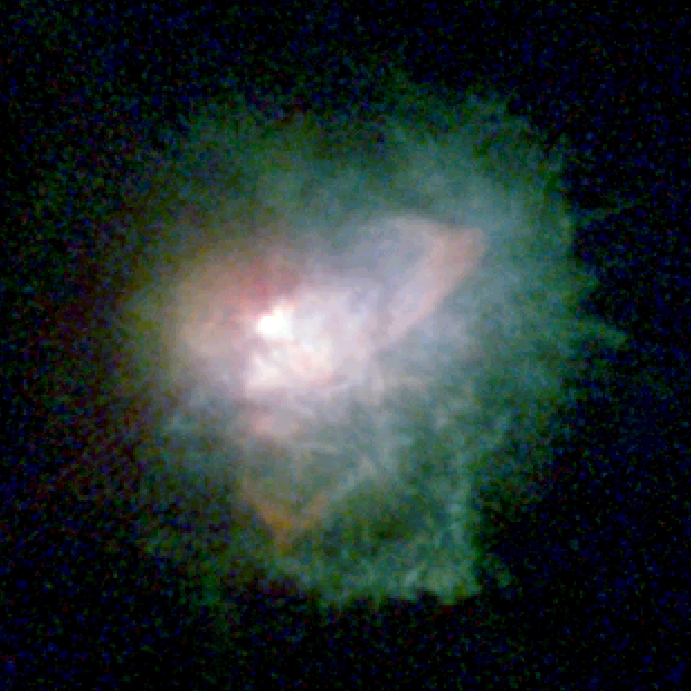The Warm and Cool Hypergiants
A few highly unstable, very massive stars lie on or near the empirical upper luminosity boundary in the HR diagram. Here we use the term hypergiant for the evolved stars that lie just below this upper envelope with spectral type s ranging from late A to M. They represent a very short-lived evolutionary stage, characterized by high mass loss and eruptive events. Many of them are strong infrared sources and powerful OH masers. The intermediate temperature or warm (yellow) hypergiants and the most luminous cool or red hypergiants are examples of high mass loss events in the evolved post-main sequence massive stars most likely with initial masses above 20 - 25 Msun. The warm hypergiants with their very high mass loss rates, circumstellar nebulae and dusty environments are excellent candidates for post-red supergiant evolution.
Here we highlight the extreme red hypergiant VY CMa and the post RSG warm hypergiants IRC +10420 and Var A in M33.
The powerful infrared source and OH maser VY CMa is one of the most luminous and largest evolved cool stars known. With its very visible asymmetric nebula combined with its high mass loss rate, VY CMa is a special case even among the cool hypergiants that define the upper luminosity boundary in the HR Diagram. Multi-wavelength HST/WFPC2 images of VY CMa [] reveal a complexcircumstellar environment Figure 1 dominated by three prominent arcs plus bright clumps of dusty knots near the star, all of which are evidence for multiple and asymmetric mass loss episodes. The random orientations of the arcs suggested that they were produced by localized ejections, not aligned with an axis of symmetry.
Second epoch HST/WFPC2 images to measure the transverse motions, which when combined with the Doppler velocities [], provide a complete picture of the kinematics of the ejecta including the total space motions and directions of the outflows []. The arcs and clumps of knots are moving at different velocities, in different directions, and at different angles relative to the plane of the sky and to the star, confirming their origin from eruptions at different times and from physically separate regions on the star. They were ejected in separate events over the past 800 years. The clumps and arcs are massive, with masses on the order of few × 10-3 M⊙ [4]. This activity could be due to magnetic/convective regions and events analogous to solar activity, i.e. "starspots". Starspots and large surface "asymmetries" have been observed on several stars including Betelgeuse and other red giants, AGB stars and supergiants. The magnetic field strength has now been measured in the ejecta of many of these stars from their OH, H2O, and SiO masers []. For VY CMa they imply surface field strengths of the order of 200 -- 400 G. Large-scale convective activity may thus be a cause of high mass loss episodes in evolved, luminous cool stars leading to the formation of intricate arcs and loops as the shocks move through the ejecta from the star's more quiescent outflow.
The post red supergiant IRC~+10420 is a powerful infrared source, the warmest maser source known and in the past 30 years or so its apparent spectral type has gone from late F-type to a mid-A. HST/WFPC2 images [] reveal a complex circumstellar environment Figure 2, with a variety of structures including condensations or knots, ray-like features, and several small, semi--circular arcs or loops within 2" of the star, plus one or more distant reflection shells. These features are all evidence for high mass loss episodes during the past few hundred years. Like VY CMa, the circular polarization of its OH masers imply the presence of magnetic fields in its ejecta with a surface field of 300 -- 400G at the star.
Tiffany et al. [], measured the transverse motions of numerous knots, arcs, and condensations in its inner ejecta from second epoch HST/WFPC2 images. When combined with the radial motions for several of the features, the total space motion and direction of the outflows show that they were ejected at different times, in different directions, and presumably from separate regions on the surface of the star. These discrete structures in the ejecta are kinematically distinct from the general expansion of the nebula and their motions are dominated by their transverse velocities. We find that they are all moving within a few degrees of the plane of the sky. We are thus viewing IRC~+10420 nearly pole-on and looking nearly directly down onto its equatorial plane. This result is confirmed by independent interferometry [] and the polarimetry [].
Recently Shenoy et al.2016 [] found that IRC~+10420's spectral energy distribution at the long wavelengths (11 - 37 μm) from SOFIA/FORCAST imaging cannot be explained by a single mass loss rate. A substantial change in the rate of mass loss that occurred in the past several thousand years is required. Although the transition was very likely gradual, at least two high mass loss periods are required. The first, from about 6000 years ago ago with a very high mass loss rate of 2 × 10-3 M⊙ per year, dropped to about 10-4 M⊙ per year beginning about 2000 years ago. We suggest that this change in the mass loss rate is due its post-red supergiant evolution to warmer temperatures.
Variable A in M33 was one of the original Hubble- Sandage variables and one of the visually brightest stars in M33 with relatively blue colors like an F-type supergiant, when in 1950 it rapidly declined 3 mags. or more becoming very red Figure 3. Its spectrum in 1985-86 was that of an M supergiant and it had a strong IR excess []. In 2004-05 its spectrum had returned to its prior warmer F-type and it had gotten bluer []. Var A obviously experienced a high mass loss episode with the formation of a much cooler optically thick wind or false-photosphere which lasted \≈ 45 years! Its apparent transits on the HR Dagram, from ~ F to M and back to an F-type spectrum, are not due to interior evolution, but to changes its wind or photosphere. Nevertheless, for 45 years, Var A looked like an M supergiant. It was an impostor! Var A is an example of another kind of impostor, produced by a cool dense wind. Var A is a warm hypergiant that is very likely is an post-red supergiant state experiencing high mass loss episodes as it evolves to warmer temperatures. Additional candidates for post-red suepergiant evolution with dusty circumstellar environments and the spectrosciopic signatures for high mass loss are described by [] and [].
The Mass Loss Mechanism
Mass loss from red giants and red supergiants (RSGs) has been known since the 1960’s, but the mass loss mechanism for red supergiants is still not understood. The leading processes have included radiation pressure on grains, pulsation and convection. Pulsation and dust-driven winds have been successful at explaining the mass loss of the Miras and AGB stars which are fundamental mode pulsators, but are not adequate for the less variable RSGs with their very extended low density atmospheres.
The defining signature of mass loss in RSGs is the presence of circumstellar dust usually revealed as excess radiation in their spectral energy distributions (SEDs) from the silicate emission features at 10 and 20 μm. To a first order, the strength of the silicate emission feature appears to be correlated with the luminosity and apparent temperature as revealed by the spectral type; i.e, the higher the luminosity and later the spectral type (or cooler the star) the stronger the silicate emission and the larger the infrared excess. But the measured mass loss rates at a given luminosity have a large scatter of 10 to 100 times [], suggesting that other factors are important such as the mass loss mechanism or evolutionary state.
Ground and space-based high resolution imaging and interferometry of evolved massive and luminous stars are transforming our view of circumstellar ejecta, mass loss and the mass loss mechanism in evolved stars. The discovery of large-scale surface asymmetries or hot spots on the surfaces of red supergiants, which vary on timescales of months or years, lends support for convection as an important mechanism for the RSGs. The massive arcs and clumps of knots in the ejecta of VY CMa and IRC~+10420, plus the presence of magnetic fields in their ejecta and in other RSGs and AGB stars, suggest that enhanced convective activity together with magnetic activity may be important for these high mass ejections.



